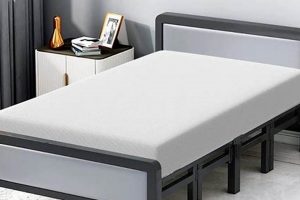A sleeping surface designed for a futon frame, specifically sized to accommodate one person. These mattresses typically measure around 39 inches wide and 75 inches long, aligning with standard specifications for single beds. They offer a flexible alternative to traditional beds, suitable for smaller living spaces or multi-purpose rooms.
These versatile sleeping solutions provide a comfortable and space-saving option. Historically, futons originated in Japan as thin, foldable mattresses. Modern adaptations offer varied levels of thickness and construction, impacting both comfort and durability. The adaptability of this bedding makes it suitable for guest rooms, dormitories, and apartments where maximizing space is a key concern.
The ensuing discussion will delve into the various materials, construction methods, comfort levels, and practical considerations involved in choosing the right futon mattress for individual needs.
Optimizing the Selection and Use of a Futon Mattress
The following guidance aims to assist individuals in making informed decisions regarding selection, care, and appropriate use, ensuring longevity and maximizing comfort.
Tip 1: Prioritize Material Composition: Consider the filling materials. Options include cotton, foam, innerspring, and combinations thereof. Cotton tends to compress over time, potentially reducing support. Foam offers consistent density. Innerspring models provide enhanced support similar to traditional mattresses.
Tip 2: Evaluate Thickness and Density: Thickness influences comfort level. A thicker mattress generally provides greater cushioning. Density impacts durability; higher-density materials tend to withstand compression better. Assess needs based on intended frequency of use.
Tip 3: Inspect Stitching and Construction: Examine the stitching for uniformity and strength. Reinforcement at seams can prevent premature wear. Quality construction is essential for maintaining the mattress’s shape and structural integrity.
Tip 4: Consider Support Requirements: If intended for regular sleep, consider models designed to provide adequate spinal alignment. Mattresses with layered construction, incorporating supportive foam or innerspring components, may be more suitable.
Tip 5: Assess Frame Compatibility: Ensure compatibility with the futon frame. Measure the frame’s dimensions to confirm the correct fit. An improperly sized mattress can compromise comfort and safety.
Tip 6: Rotate Regularly: To promote even wear and prevent compression in specific areas, rotate the mattress periodically. This practice extends the lifespan and maintains consistent comfort.
Tip 7: Use a Mattress Protector: Employing a mattress protector shields against spills, stains, and allergens. A protective layer also reduces wear and tear, contributing to the mattress’s longevity.
Adhering to these guidelines will contribute to the selection of a suitable futon mattress, optimizing comfort, support, and longevity.
The subsequent section will provide further detail on the practical application and maintenance of futon mattresses.
1. Dimensions
The dimensions of a twin futon mattress are critical to its functionality and usability. These mattresses are designed to fit standard twin-size futon frames, typically measuring approximately 39 inches in width and 75 inches in length. Deviations from these standard measurements can lead to significant problems. For example, a mattress that is too wide will not properly fold into the seating position on a futon frame, rendering the futon’s dual-purpose design useless. A mattress that is too short will create gaps and discomfort when used as a bed.
The importance of adhering to specific dimensions extends beyond basic functionality. Proper fit contributes significantly to user comfort and safety. A mattress that adequately fills the frame provides consistent support across the entire sleeping surface, minimizing pressure points and promoting better spinal alignment. Conversely, a mattress that is too small or too large can create uneven support, potentially leading to discomfort and even physical strain. Real-world examples include scenarios where individuals experience back pain due to a poorly fitting mattress that fails to provide adequate support.
In conclusion, understanding the dimensional requirements of twin futon mattresses is essential for ensuring both functionality and comfort. Accurate dimensions guarantee compatibility with standard futon frames, allowing the mattress to fold correctly and provide consistent support. Failure to adhere to these dimensions can result in a compromised user experience, potentially leading to discomfort and even physical issues. The precise relationship between dimensions and the intended application underscores the practical significance of this factor in the selection process.
2. Material Composition
The material composition directly dictates its comfort, durability, support, and overall suitability for various users and environments. Understanding these components is crucial for informed decision-making.
- Core Materials and Support
The internal components, such as cotton, foam (memory foam, polyurethane foam), innersprings, or a combination thereof, establish the mattress’s support level. Cotton, while affordable, tends to compress over time, diminishing support. Foam provides consistent density but may vary in firmness. Innersprings offer enhanced support and resilience, similar to traditional mattresses. The choice of core material impacts the mattress’s ability to maintain spinal alignment and distribute weight evenly.
- Comfort Layers and Surface Feel
Comfort layers, positioned atop the core, determine the initial feel. Materials like memory foam conform to the body, relieving pressure points. Polyurethane foam offers a firmer, more responsive surface. Fiber batting, often used in combination with other materials, provides a softer, more cushioned feel. The selection of comfort layers affects the immediate comfort experienced upon contact with the mattress.
- Cover Fabrics and Breathability
The outer cover material impacts breathability, durability, and ease of cleaning. Cotton covers are breathable but may be prone to staining. Polyester blends offer enhanced durability and stain resistance. Specialty fabrics, like bamboo or Tencel, promote moisture wicking and temperature regulation. The cover material directly affects the overall comfort and hygiene of the mattress.
- Fire Retardant Barriers and Safety
Regulations mandate that mattresses include fire-retardant barriers. These barriers may consist of treated rayon, silica, or other inherently fire-resistant materials. While crucial for safety, the composition of these barriers can impact the mattr
ess’s overall comfort and breathability. Transparency regarding the types of fire retardants used is essential for informed consumer choices.
These considerations regarding material composition highlight the multifaceted nature of assessing a twin futon mattress. A comprehensive understanding of these components enables individuals to select a mattress that aligns with their specific needs and preferences, optimizing comfort, support, and durability.
3. Thickness Levels
Thickness, measured in inches, significantly influences the comfort, support, and overall suitability of a twin futon mattress for various applications. Thicker mattresses generally offer improved cushioning and pressure relief compared to thinner alternatives. The selection of an appropriate thickness level directly impacts the quality of sleep and the long-term durability of the product. For example, a thinner mattress may be suitable for occasional use in a guest room, while a thicker mattress is recommended for regular, nightly use to ensure adequate support and prevent discomfort.
The choice of thickness is also influenced by the futon frame itself. Some frames are designed to accommodate thicker mattresses, while others are better suited to thinner profiles. Using a mattress that is too thick for the frame may hinder the folding mechanism and prevent the futon from converting smoothly between seating and sleeping positions. Conversely, a mattress that is too thin may not provide sufficient support and could lead to premature wear and tear on both the mattress and the frame. Real-world examples include situations where individuals have experienced difficulty converting a futon due to an incompatible mattress thickness, or where a thin mattress has quickly deteriorated due to inadequate support.
In summary, thickness is a critical attribute of futon mattresses, directly affecting comfort, support, and compatibility with the futon frame. Careful consideration of the intended use, the frame’s specifications, and individual comfort preferences is essential when selecting a twin futon mattress with an appropriate thickness level. Ignoring this aspect can lead to compromised comfort, reduced durability, and functional issues with the futon itself. Therefore, understanding the relationship between thickness and the overall performance of the mattress is of practical significance for both consumers and manufacturers.
4. Support Capabilities
The support capabilities of a futon mattress dictate its effectiveness in providing proper spinal alignment and pressure distribution during sleep or rest. This feature is intrinsically linked to the mattress’s core construction, influencing its suitability for various body types and sleep preferences. Insufficient support leads to discomfort, potential back pain, and disrupted sleep patterns. The materials used, such as innersprings, high-density foam, or layered cotton, contribute directly to the level of support offered. A lack of adequate support in a futon mattress can negate its intended versatility and practicality, rendering it unsuitable for regular use. Real-world examples include individuals experiencing morning stiffness and backaches after sleeping on a poorly supportive futon mattress.
Different support levels cater to different needs. Firmer mattresses offer greater resistance and are generally preferred by individuals who sleep on their stomachs or backs, as they help maintain spinal alignment. Softer mattresses, on the other hand, conform more closely to the body and are often favored by side sleepers for their pressure-relieving properties. The support capabilities also affect the longevity of the mattress. A well-supported mattress is less likely to sag or develop indentations over time, ensuring consistent comfort and performance throughout its lifespan. Frame design also plays a factor, some futon frames offer increased support compared to simpler bar designs.
In conclusion, support capabilities are a crucial component in the overall evaluation of a futon mattress. It significantly impacts user comfort, spinal health, and the mattress’s durability. Understanding the various support levels available and selecting a mattress that aligns with individual sleep preferences and body type is essential for optimizing the benefits of a futon mattress. This selection should be based on individual factors, with a focus on finding the most supportive mattress possible.
5. Frame Compatibility
Frame compatibility is a critical consideration when selecting a twin futon mattress. The futon frame’s design and dimensions must correspond precisely with the mattress to ensure proper functionality, stability, and user safety. Failure to achieve this compatibility can result in operational issues, premature wear, and potential hazards.
- Dimensional Matching
The mattress’s length and width must align with the frame’s internal measurements. A mismatch can lead to overhang, instability, and difficulty in converting the futon between seating and sleeping positions. For example, a mattress that exceeds the frame’s dimensions may prevent it from folding correctly, while a mattress that is too small may shift during use, compromising support.
- Thickness Accommodation
The frame’s design dictates the maximum acceptable mattress thickness. Exceeding this limit can strain the frame’s folding mechanism, potentially causing damage or malfunction. In situations where the mattress is too thick, the futon may not lock securely in either the seating or sleeping configuration, posing a safety risk.
- Support Structure Alignment
The mattress’s support requirements must be compatible with the frame’s underlying structure. Frames with widely spaced slats may not provide adequate support for thinner mattresses, leading to sagging and uneven weight distribution. Real-world instances include users experiencing discomfort and back pain due to insufficient support from an incompatible frame.
- Locking Mechanism Engagement
Certain futon frames feature locking mechanisms that secure the futon in either the seating or sleeping position. The mattress’s thickness and overall dimensions must allow for proper engagement of these mechanisms. An incompatible mattress may prevent the locks from functioning correctly, increasing the risk of accidental collapse.
These facets of frame compatibility are inextricably linked to the overall performance and safety of a twin futon mattress. A thorough assessment of these factors ensures that the mattress and frame work harmoniously, providing a comfortable and reliable seating and sleeping surface. Neglecting this aspect of the selection process can lead to functional issues, compromised comfort, and potential safety hazards.
6. Foldability
Foldability is an inherent and defining characteristic of futon mattresses, directly impacting their utility and adaptability within a variety of l
iving spaces. Its presence enables the transformation between seating and sleeping configurations, making futons a practical solution for space optimization.
- Material Composition and Hinge Points
The materials used in the construction influence the ease and efficiency of folding. Cotton-filled mattresses, while pliable, can develop permanent creases at hinge points with frequent folding. Foam mattresses offer more consistent folding but may require segmented construction to avoid stiffness. Innerspring models typically have limited foldability due to their rigid structure. Material choices directly impact the longevity of the folding mechanism and the overall comfort in both seating and sleeping positions. Real-world examples include futons with compressed cotton fillings that resist folding after prolonged use as a sofa.
- Thickness and Folding Radius
Thickness is inversely proportional to the achievable folding radius. Thicker mattresses necessitate a wider folding arc, potentially increasing the overall footprint in the seating configuration. Thinner mattresses fold more compactly, but may compromise comfort and support. The selection of an appropriate thickness must balance space-saving requirements with ergonomic considerations. Examples include individuals experiencing difficulty fitting a folded futon into a limited living area due to excessive mattress thickness.
- Construction Techniques and Flexibility
The method of construction impacts the mattress’s flexibility and resistance to deformation. Tufted construction, where the filling is secured through the mattress, can enhance foldability by preventing shifting and bunching. Segmented construction, with distinct sections separated by flexible materials, promotes easier folding along defined lines. Techniques that reinforce hinge points are critical for preventing wear and tear. Examples include futons with torn seams at the folding points due to inadequate reinforcement.
- Frame Design and Folding Assistance
The design of the futon frame significantly influences the ease of folding. Frames with integrated lifting mechanisms or counterbalanced hinges reduce the physical effort required to convert between configurations. Frames that provide adequate clearance and support the mattress evenly during folding minimize stress on the mattress materials. Examples include futons with frames that require significant force to fold or unfold due to poor design, leading to potential damage and user strain.
These intertwined aspects of foldability underscore its fundamental role in defining the function and practicality of a twin futon mattress. The effectiveness of the folding mechanism hinges on material choices, construction techniques, and frame design, all of which contribute to the overall usability and lifespan of the product. Understanding these factors allows consumers to make informed decisions that balance space-saving benefits with long-term performance.
7. Cover Material
The cover material on a twin futon mattress serves as the outermost layer, directly influencing durability, hygiene, comfort, and aesthetics. A primary function is to protect the inner components, like cotton, foam, or innersprings, from damage due to spills, stains, and abrasion. The chosen cover material determines the mattress’s resistance to wear and tear, affecting its lifespan. Examples include scenarios where a water-resistant cover prevents liquid penetration, thereby inhibiting mold growth and extending the mattress’s usability. Breathable materials, such as cotton or linen, facilitate air circulation, mitigating heat buildup during sleep. Non-breathable materials, like vinyl, can lead to discomfort due to trapped moisture.
Furthermore, the cover material impacts the ease of maintenance. Washable covers allow for regular cleaning, promoting hygiene and preventing allergen accumulation. Stain-resistant treatments minimize the appearance of blemishes, preserving the mattress’s aesthetic appeal. Different fabrics offer varying degrees of texture and softness, influencing the tactile experience. For instance, a quilted cover provides additional cushioning and a more luxurious feel. The selection of cover materials should align with anticipated usage patterns and environmental conditions. High-traffic areas or environments prone to spills necessitate durable, stain-resistant covers, while infrequently used futons may benefit from softer, more aesthetically pleasing options.
In essence, the cover material is an integral component of a twin futon mattress, significantly affecting its protection, longevity, comfort, and ease of care. Understanding the properties of different cover materials allows for informed decisions, aligning the selection with individual needs and usage scenarios. Challenges arise in balancing durability, breathability, and cost, requiring careful consideration of trade-offs. The cover material is not merely an aesthetic choice, but a functional element crucial to the mattress’s overall performance and lifespan.
Frequently Asked Questions
The following questions address common inquiries and misconceptions regarding the selection, care, and use of these mattresses. This information aims to provide clarity and assist in making informed decisions.
Question 1: What are the standard dimensions of a twin futon mattress?
The standard dimensions are approximately 39 inches wide and 75 inches long. Adherence to these measurements ensures compatibility with standard futon frames.
Question 2: How does material composition affect the performance?
Material composition influences comfort, support, and durability. Options include cotton, foam, and innerspring, each offering distinct characteristics regarding support and longevity.
Question 3: Is mattress thickness a significant factor?
Thickness is a crucial determinant of comfort and support. Thicker mattresses typically provide greater cushioning and pressure relief, while thinner options may be more suitable for infrequent use.
Question 4: What level of support should be expected?
The level of support required varies based on individual preferences and sleeping habits. Firmer mattresses are generally recommended for back sleepers, while softer options may be preferred by side sleepers.
Question 5: How important is frame compatibility?
Frame compatibility is essential for ensuring proper functionality and safety. The mattress must align with the frame’s dimensions and support structure to prevent instability and operational issues.
Question 6: What factors influence foldability?
Foldability is affected by material composition, thickness, and construction techniques. These elements determine the ease with which the mattress can be converted between seating and sleeping positions.
In summary, careful consideration of dimensions, material composition, thickness, support, frame compatibility, and foldability is essential for selecting a suitable futon mattress.
The subsequent section will address specific maintenance and care considerations to maximize the longevity and performance of futon mattresses.
Twin Futon Mattress
This exposition has detailed the multifaceted aspects of the twin futon mattress, examining its dimensions, material composition, thickness, support capabilities, frame compatibility, foldability, and cover material. It underscores the importance of understanding these features to make
informed purchasing decisions. The preceding information provides a framework for evaluating the suitability of various options based on individual needs and circumstances.
The selection of a futon mattress represents a balance between versatility, comfort, and durability. Recognizing the impact of each characteristic on the overall performance ensures a valuable investment. Further research and practical application will continue to refine the understanding and optimization of these sleeping solutions for compact living spaces.


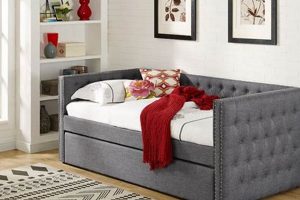
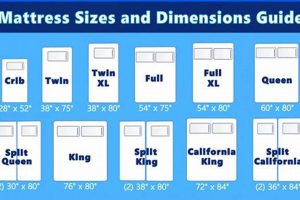
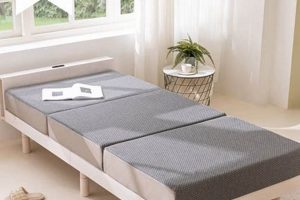
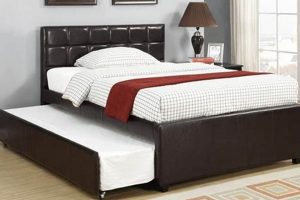
![Best Adjustable Mattress Twin Size [Guide 2024] Organic & Natural Mattress Buyer’s Guide: Non-Toxic Sleep Solutions Best Adjustable Mattress Twin Size [Guide 2024] | Organic & Natural Mattress Buyer’s Guide: Non-Toxic Sleep Solutions](https://mattressworldpa.com/wp-content/uploads/2025/07/th-5087-300x200.jpg)
